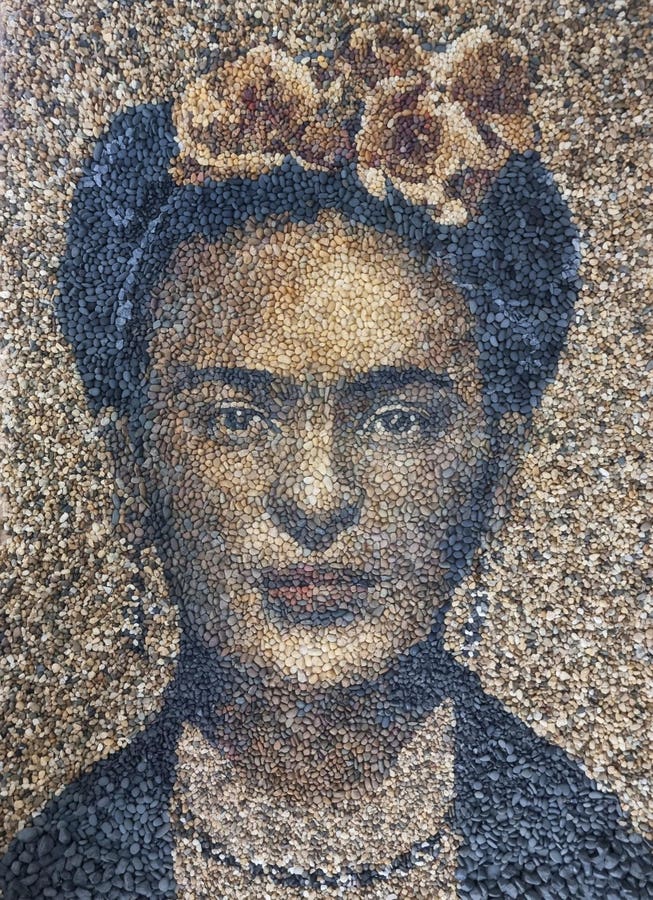Portrait of Frida Kahlo by Justin Bateman
Photo courtesy of Justin Bateman
Justin Bateman has swapped brushes for stones and canvases for beaches or forests, crafting astonishingly detailed portraits out of pebbles. Working under the moniker “PebblePicassos”, he uses nothing more than the natural tones and textures of stones he finds on-site to recreate famous faces – from Michelangelo’s “David” to David Bowie – in intricate mosaic-like compositions. These works, made entirely in nature and left to be reclaimed by it, speak to a deep reverence for impermanence and the fleeting beauty of the world around us. Each portrait is a meditation on time, place and presence, inviting viewers to appreciate the profound connection between art and the natural world.
How do you document your artworks?
Having created the work, I document everything with my mobile phone. Social media gets a lot of bad press which I understand, but it has provided a network, gallery and exhibition space I truly value. I have spent the last years traveling and making art using only my mobile phone. My artist friend in Mexico, a collector and art dealer called Rick Wolfryd, often encourages me to take a more professional approach, increasing the quality of my photography. An important aspect of my work is that it is so accessible. Anyone who has a mobile phone can do what I do; it is inclusive. I am willing to forego the final tweaks that a professional photographer would demand to retain the work’s immediacy. My tools are deliberately minimalist rather than a product of apathy.
Do you sell the photos that you take of your pebble mosaics?
It has been a hard decision to monetize my work. At first, I chose not to monetize anything at all; I kept my capitalist and creative tendencies very separate. As my work became more widely known, I have received hundreds, if not thousands, of requests for artwork, prints and commissions. I have always felt that if I create something of enough true value, I will be compensated by life itself. No action is without reciprocal events, no matter how unseen or small it may appear. Sometimes I accept commissions or requests if they align with my own intuition as something that should be made. For example, I had a request from Save the Children in Yemen. The next day, I walked past a demolition site and felt the location was apt, considering the widespread devastation from bombing. Some people consider my work political; I see it more as a comment on the human condition. I don’t select subjects in support of their cause or in affiliation with their political ideology. I select them from a point of inquiry, an objective observer in accordance with the availability of materials and locations. No subject is dismissed outright. There are many variables to consider, but it isn’t solely a matter of esthetics.
Justin Bateman, David (after Michelangelo)
Photo courtesy of Justin Bateman
How do you earn a living from your art?
I developed some fun products which I sell on Etsy, mostly day-to-day items using images of my work. I don’t really want to fill the world with any more “stuff”. I figured if we need to wear socks, there’s no harm in making them fun. There’s some Dostoevsky flip flops and a Cherub tote bag. I don’t take it all too seriously. It’s quite a random collection of images. You may find a Communist leader, a Renaissance painting and a prophet all on the same tea towel!
Rick also developed some very high-quality limited-edition signed prints of “Messiah”, embossing certain parts of the image and numbering them in Hebrew numerals. Great attention is paid to the whole process. I am also really excited about my more permanent pieces. They are in addition to my main, impermanent practice. There is huge potential with my permanent mosaics, but I deliberately limit the audience to which I advertise them. I am careful not to become a conveyor belt of art. We already have plenty of options for bathroom floors.
How have your works been received?
My latest projects have been quite internationally oriented. I have had huge support from countries who celebrate historical leaders, like mass demonstrations of gratitude for those who strove to improve the quality of life for their people. Many are keen to know “who is this man who is making our leader from stones?” The answer is, just an eccentric chap who needed something to do with his hands. Each work is like a small celebration of the nature of existence, its curious assembly and, of course, its impermanence.
What do you feel is the role of the artist in society?
Existential questions seem to have plagued mankind since the development of opposable thumbs – I am not exempt. All I can say is that my mind is quieter when I’m working with my hands. I can worry about matching hues as opposed to who will start the next world war, I can explore locations rather than fret about my pension disappearing through inflation. The redirection of imagination from fear to creativity is an act of extraordinary magnitude. Where attention goes, energy flows, and if you find yourself playing with stones the next time you’re at the beach, I’ll feel I did just enough to contribute something good to the world. It’s a legacy that I can feel happy about.
What new projects are you currently working on?
Now I receive invitations from all over the world, requests to lead community projects or regeneration schemes, commissions of figureheads and even television appearances. But I’m happy in the mountains of Chiang Mai in northern Thailand. I live between here and Ubud in Bali most of the time. The cultures here are gentle, respectful and spiritual. I’ve come a long way from my hometown in the UK, but home is where your heart is, and my heart is in the stones wherever I am.

